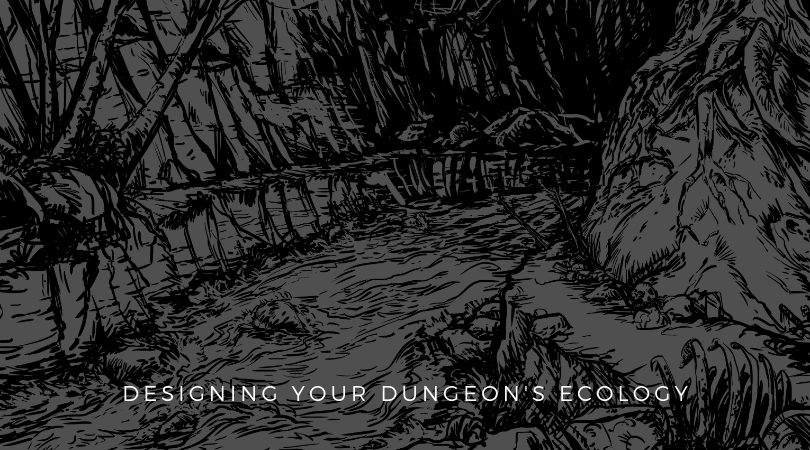Designing Your Dungeon’s Ecology

Designing a dungeon badly is a doddle—sketch out some rooms and randomly stock them with monsters and treasure. Include as little detail as possible, and you are done.
Taking the extra time to consider the basics, though, is time well spent.
I’ve previously talked about the big picture of dungeon design. Just as important as questions about who built the dungeon (and why) are more mundane details. The devil is in the detail, after all. Ignoring a dungeon’s basic characteristics and those of its inhabitants can shatter the players’ suspension of disbelief. (But, a word of warning, obsessing over every tiny detail is not a path you want to go down—trust me.)
The Basics
Consider the basics of your dungeon its foundation in reality.
Food & Water
Some dungeon denizens, such as elementals and most undead, don’t need to eat or drink. Most others, however, require sustenance to survive. If the means to acquire food and drink do not exist in the dungeon, they must be obtained elsewhere (preferably easily from somewhere close by).
Access
Pretty much every denizen needs to move about. Creatures need to gather food and water at the most basic level. They may also trade or work with their neighbours, creep forth to raid the surface lands and so on. To do this, they need to be able to leave the dungeon.
The classic example of this is the monster living in a room only accessible through another monster’s lair. Sure, the two might be allied, but would you live in a place where you were beholden to your neighbour for everything?
Conflict & Alliances
It is unlikely the denizens of a dungeon exist in a bubble of isolation, not interacting with each other. As in any community, alliances, rivalries and conflicts will be present among the dungeon denizens. Clever explorers can learn of these and exploit them to their advantage.
Why Are They There?
Consider why the denizens are living in the dungeon. Have they chosen to be there? Are they trapped? Are they there because they are searching for something? Shockingly, most monsters don’t just hang around in their lair waiting to be slaughtered by rampaging adventurers.
Light
While most won’t, some dungeon denizens need light. If they do need it, they must have a means of providing light practically continually.
Unoccupied Rooms
Empty rooms are a vital part of dungeon design that has fallen out of fashion in recent years through the tyranny of falling page counts and increased space given over to the crunchy bits of modules. (And the desire to fit the entire dungeon onto one table-sized battle mat).
Unoccupied rooms can contain furniture, hidden secrets, interesting dungeon features and even treasure! Skilled players can learn a lot about a dungeon by poking around empty rooms.
Dungeons need empty rooms because:
They Provide a Change of Pace
Empty rooms provide a break from the constant grind of combat that often occurs in dungeon delving and allows the characters to catch their breath.
They Have Dressing
Empty rooms can be interesting places to poke about. They can contain features that, although not intrinsically valuable, build on the flavour and style of the dungeon.
They Enable Skill Checks
Empty rooms practically beg to be investigated. Perception checks, Knowledge checks and so on (depending on your game of choice) can all be used to learn more about the location. Canny players can use this information to their advantage. If, for example, the party explore an unoccupied barracks and note there are 20 bunk beds in the room, they get a good idea of the size of the garrison. That could be very useful information to have.
They are a Place to Rest
Empty rooms are a great place to rest. An easily defensible, empty room or one that is remote from the main complex is even better!
They Enable Verisimilitude
Empty rooms add to versimilitude. Not every room in a dungeon should be stuffed full of villains waiting to be slain. Some rooms are used for storage, meeting, sleeping or ceremonial purposes. They won’t all be occupied all the time. If foes occupy every room, it is virtually impossible for the characters to move through the dungeon without every denizen charging to the aid of their companions. Delves into such badly designed dungeons usually end up in a very large, bloody and long-winded fight the characters have no real chance of winning.
The Ultimate in Bad Design
I’ve discussed this before, but I felt compelled to mention this here again. “It’s magic” is the ultimate rationale for lazy design. “It’s magic” can sweep away almost any logical inconsistency. It says to me, though, that either the designer doesn’t care about creating a plausible dungeon or they don’t know they’ve failed horribly. (Of course, some extra-planar dungeons or the lair of a powerful wizard could prove the exception to this rule, but such examples are few and far between).
Final Word
Remember: some detail is good, but too much is bad. Strike the right balance between creating a believable, “realistic” dungeon and a fun dungeon and your players will thank you for it!

Member discussion